|
|

 A new spirit of social progress A new spirit of social progress The
assault on Christian ethics and the Christian worldview The
assault on Christian ethics and the Christian worldview The
Kennedy Era comes to a tragic end – November 1963 The
Kennedy Era comes to a tragic end – November 1963
The textual material on this webpage is drawn directly from my work America – The Covenant Nation © 2021, Volume Two, pages 162-170. |

|
|
The life work of the Rev. Dr. Martin Luther King, Jr., provides another insight into how America went about its national and international business at the beginning of the 1960s. Serious blemishes existed in the "model" nation in the form of deplorable racial relations, especially in the American South. Crude racism (graphically covered by the American press) gave the nation’s Communist enemies golden opportunities to blast America as a hypocritical model of freedom and justice. And it certainly did nothing to promote America’s growing interest in the continent of Africa where sensitivity to White racism ran deep. Blacks were coming awake to their political rights as American citizens and beginning to demand that segregation be brought to an end. Particularly active in this matter were the NAACP and the SCLC (Southern Christian Leadership Conference), the latter led by the Rev. Dr. King. Northern voices also joined Southern Blacks in demanding an end to this embarrassing and most "un-American" violation of the rights of Black citizens. Then in early 1963 the SCLC conducted a well-publicized (and often violent in terms of the reactions its sparked among some Southern Whites) campaign of desegregation of Birmingham, Alabama's downtown businesses – resulting in the Rev. Dr. King’s arrest and brief detention ... and the outrage of American Northerners. King’s appeal to the conscience of the nation And thus the decision was made by King to take the case of integration all the way to the nation’s capital. Thus hundreds of thousands of people, Black and White, descended on Washington, D.C., on August 28, 1963, to demonstrate their support for national action with regards to racial integration. Note that King held no public office; he
was not part of the "machinery" of government. Yet he understood what
truly governed the country: its moral heart and its noble vision of
America, as a land where the glory of the Lord is to be evidenced to
the world in the way God’s children live together in a spirit of
equality, opportunity, and personal freedom. With this higher vision,
King challenged that same American heart – and thus "governed" the
country by challenging the nation to try harder to live by its own
moral ideals. True, a goal of his was federal legislation guaranteeing
the right of all Blacks to vote. But he understood that such
legislation would result only if the hearts of the American people were
awakened to the need to instruct their representatives to make a
positive move on this issue. Thus ultimately his appeal was not to the
government in Washington, but to the government found in American
hearts across the nation. He began by explaining the great dream he had – that the day could come when the nation truly lived according to its creed, when the sons of former slaves and slave owners would sit down together as brothers. He detailed that same dream as the day when freedom and justice would reign in Mississippi, when in Alabama little black children and little white children would live together as brothers and sisters … when the day would come that freedom would ring across the country, from New Hampshire and New York to Georgia and Mississippi. And he concluded this moving oration by taking from the words of an old spiritual that thanked God himself for that freedom. Answering the call America quickly recognized this blemish – much of Southern White America excepted, of course. And under the leadership of King and the Kennedy brothers, and with the dedicated support of countless college students, Christian pastors, university professors, journalists and northern politicians – who headed South to help remedy this problem – America began an assault on this blemish. Also, for the idealistic American generation of Boomers just starting to emerge into adulthood, this was a "no brainer" in terms of choosing sides in this issue. Indeed, it became their first opportunity to take up the grand moral fight against authoritarian tyranny for which they had long been prepared. A grand moral crusade beckoned. At the time (the early 1960s) the issue
was seen purely in legal terms: the lack of voters' rights of Blacks in
the American South – Americans being certain that the "democratic
process" was the cure for all social evils. And so a massive voter
registration campaign, opposed violently by Southern state authorities,
got underway – resulting finally in a grand civil rights victory for
American Blacks when the national Voting Rights Act was passed in 1965.
|
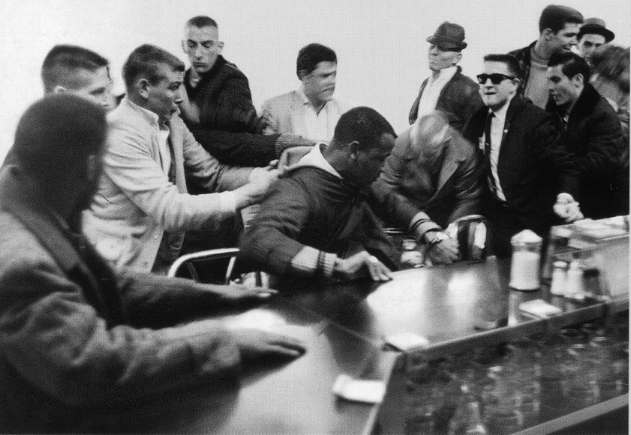
Confrontation at a segregated
food counter in Nashville – March 1960
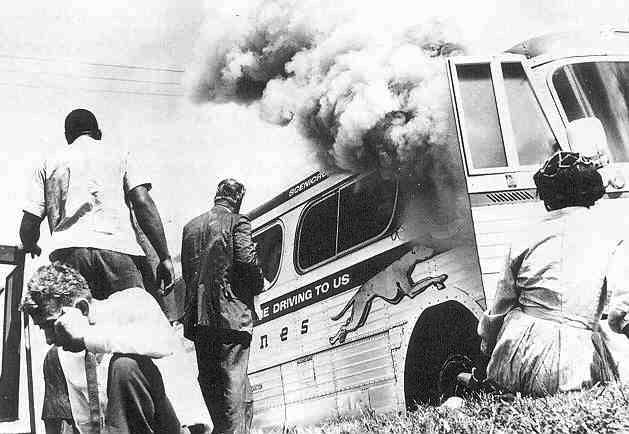
Freedom Riders beaten and
their bus burned outside of Anniston, Alabama – 1961
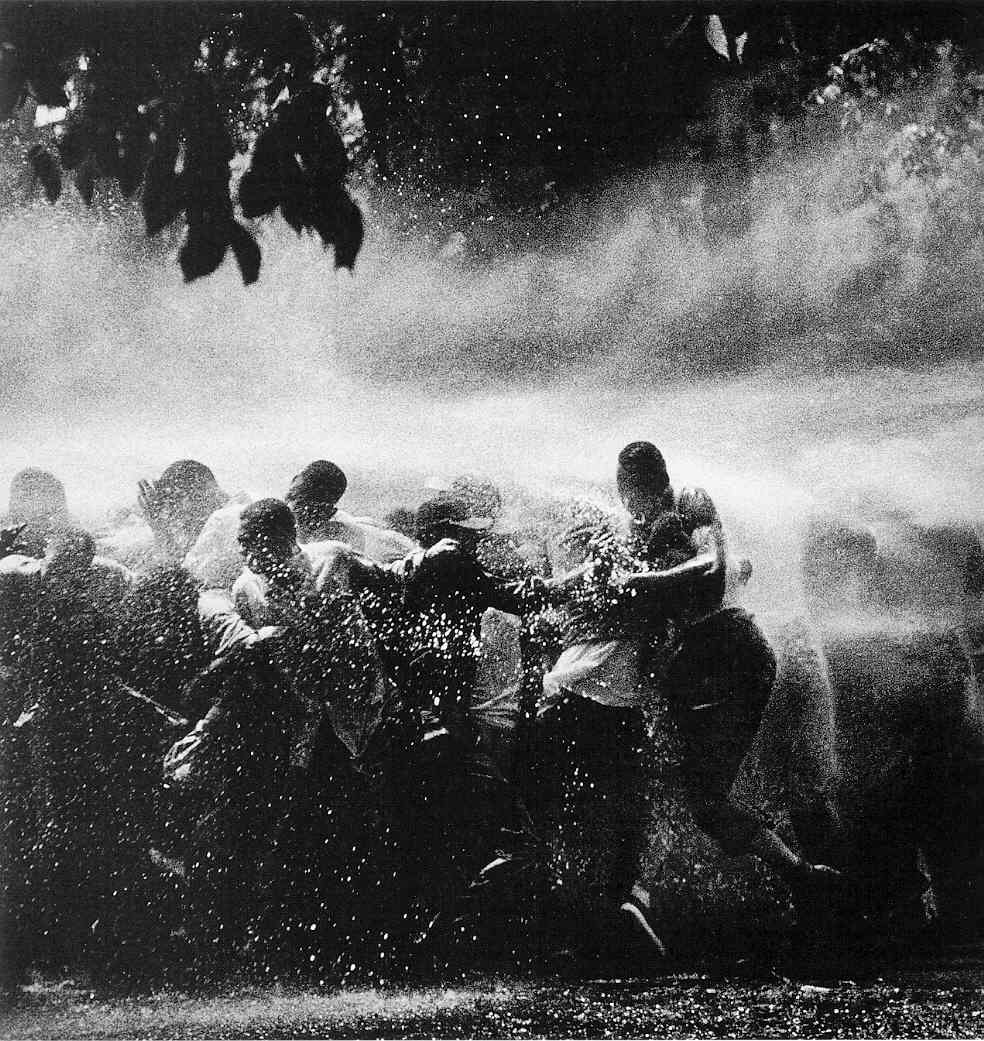
Fire hoses being turned on
protesting Blacks
by orders of Birmingham police chief Bull Connor –
1963
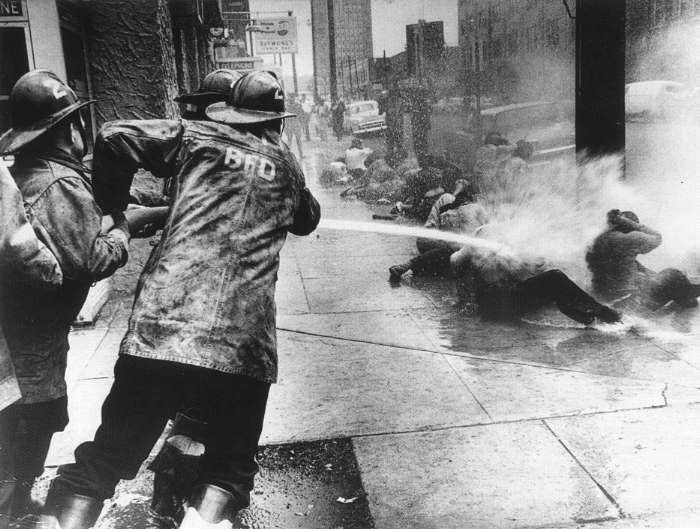
Birmingham Alabama firemen
using a firehose in an effort
to disperse Blacks protesting segregation
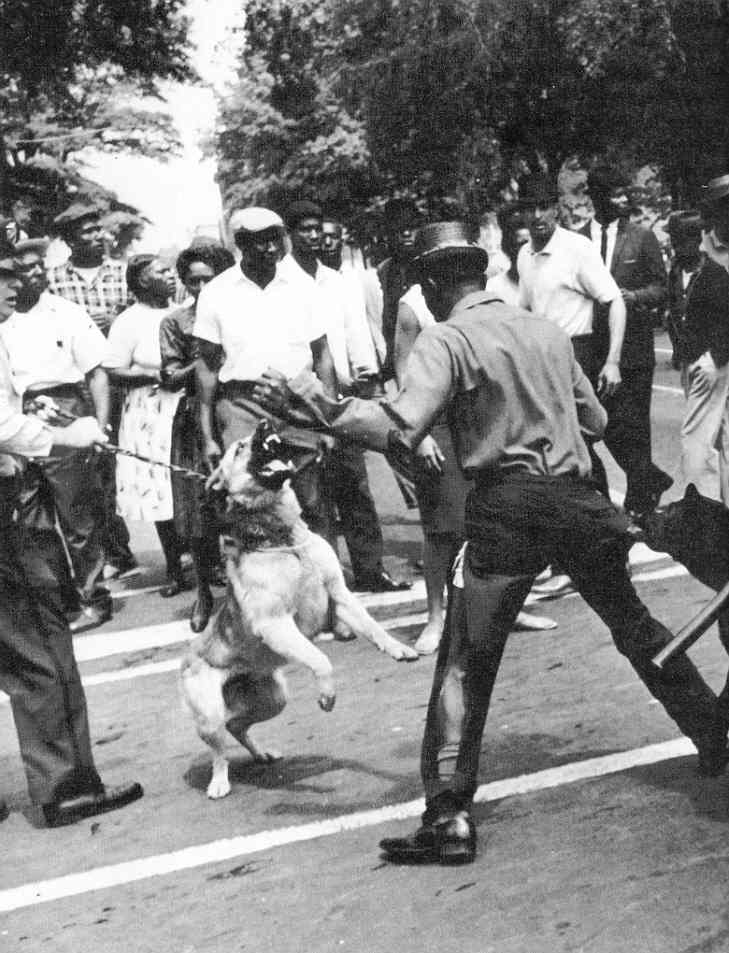
A Black demonstrator in
Birmingham,
Alabama, being attacked by police dogs – April 1963
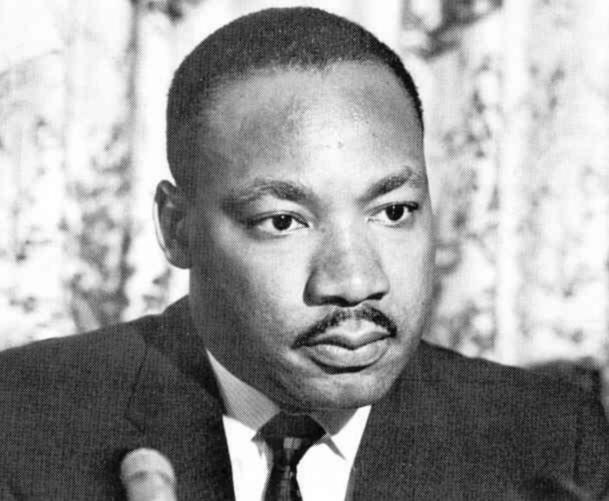
Dr. Martin Luther King,
Jr.
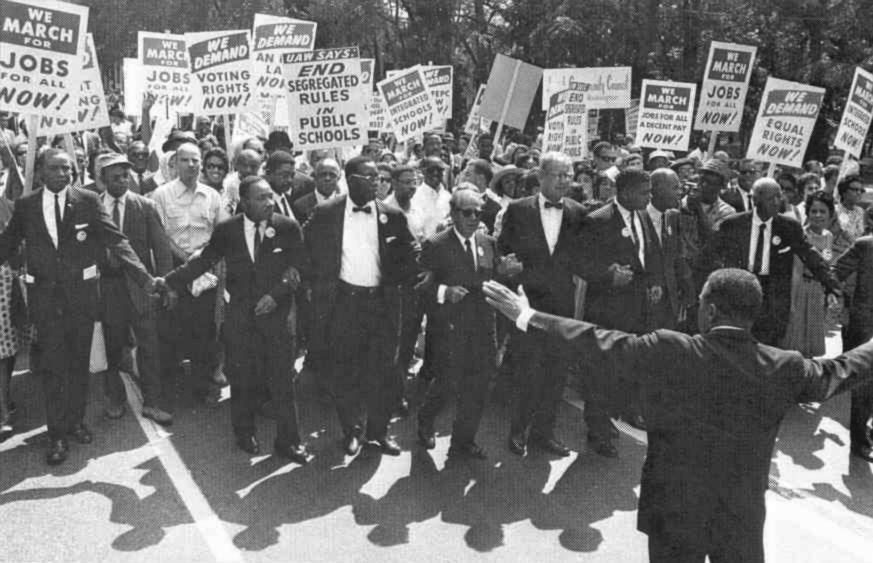
Martin Luther King, Jr. and
other protesters during the March on Washington
for Jobs and Freedom –
1963
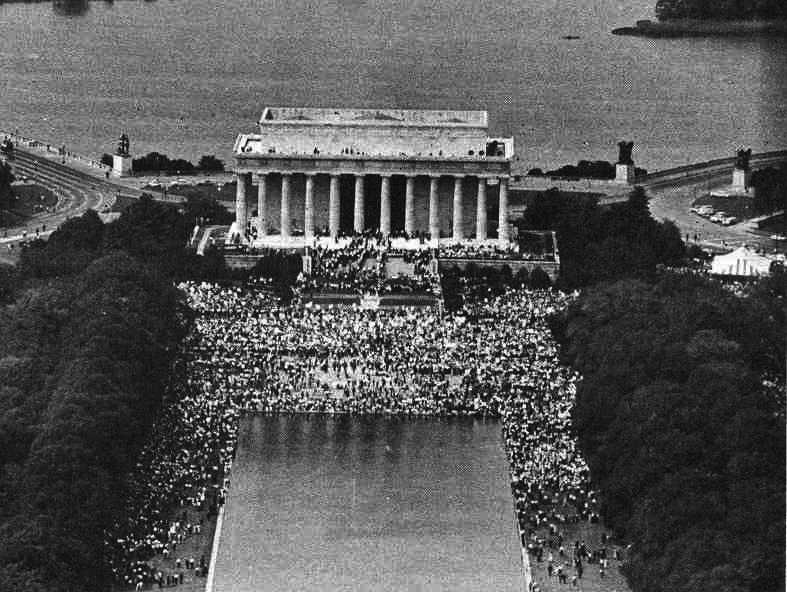
Civil Rights March on Washington
– August 28,1963
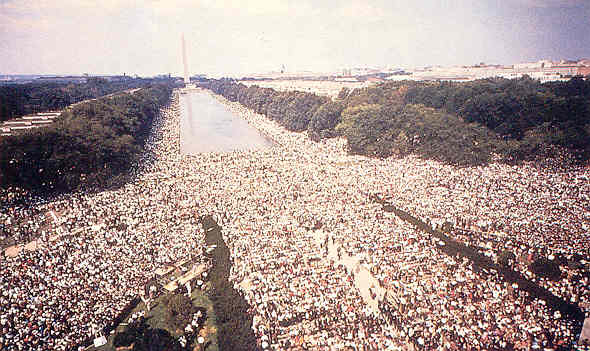
The March on Washington
–
August 28, 1963
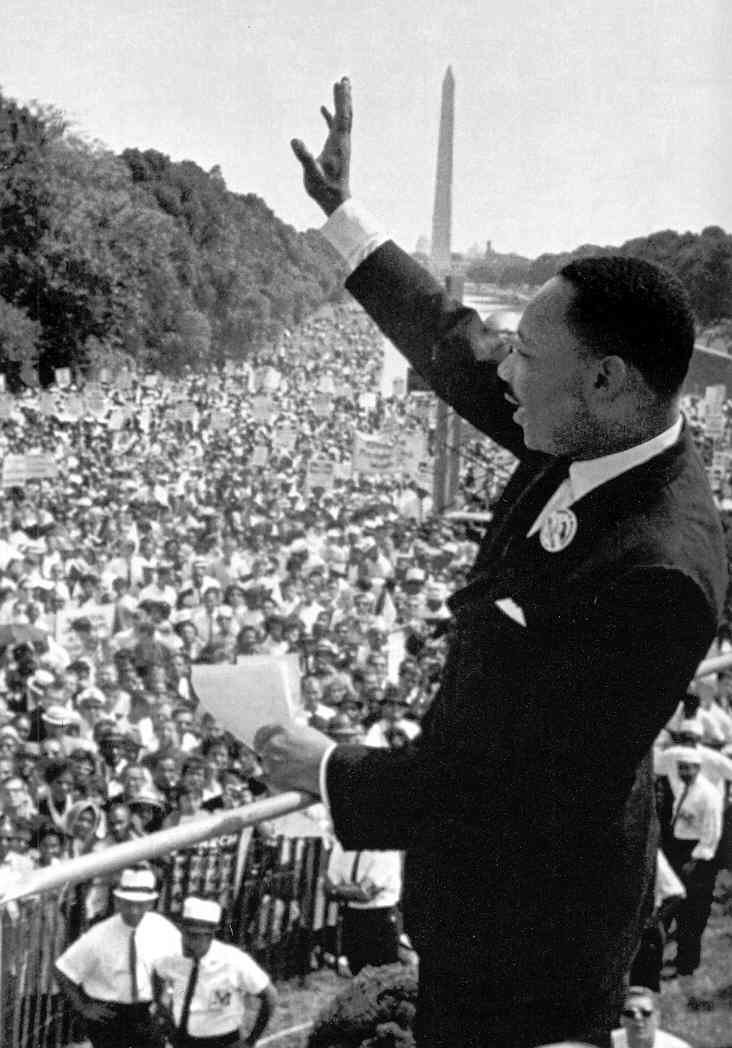
Dr. Martin Luther King, Jr.
and the March on Washington – August 28, 1963
Dr. Martin Luther King before
a 250,000-strong crowd on the Washington Mall – August 28,
1963
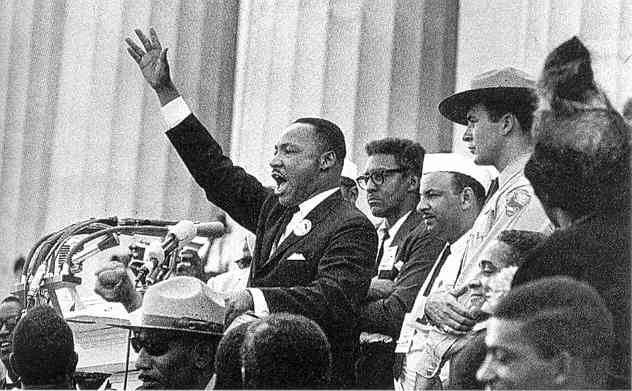
Dr. King delivering his "I Have a Dream" speech – August 28, 1963

|
|
A sense of progress was everywhere in America in the early and mid-1960s. America was cleaning up the last of its social-cultural act with new legislation finally ending the refusal of Southern states to allow their Black citizens the right to vote. A sense of civil rights for every group that did not share fully in the social-cultural mainstream of America, legal rights enacted by our Federal courts and Congress, was looming into view. With the proper management of American politics (coming from an expanding corporate or managerial State based in the nation’s capital), America could be fine-tuned to become the shining beacon of political excellence that the world needed in order to keep its sights set on the good and the perfect – and not fall victim to the wily evils of Communism. This step into a well-managed future seemed so logical, so necessary that it was almost impossible to resist, or even question, the character of this new mood or movement.
|

|
|
As America’s old racial lines came under serious revision, another dividing line began to take center stage: the Christian/Secular division. The Vet generation was fervent in its Christian identity. So hostile was it to the godlessness of Communism that in 1954 it had the phrase "under God" added to the American Pledge of Allegiance. But associating Christianity with the culture of the Vets would prove to be a problem with the rise of the Boomer, who by the late 1960s had developed the instinct to be fervently opposed to everything that their Vet parents fervently supported. And that included Christianity. As the Boomer put it, why not Buddhism? Why not Taoism? Why not Hinduism? What's so special about Christianity? It's just another moral code like any other. Indeed, Boomer youth had been raised in Sunday schools in the 1950s to understand that Christianity was essentially a social or moral code, something about being good like Jesus. A big part of the problem facing Christianity was the way the Vets had allowed the faith to slip into the status of being a civic religion. It was so closely tied to the prevailing self-image of America as a Christian nation, right in there with Capitalism and Democratic Idealism, that it became in many ways indistinguishable from these other facets of American culture. Christianity took on the polish of the well-managed American corporation engaged in the business of men’s and women’s clubs, youth organizations, the leisure arts (from summer camps, to sports programs, to boy-girl "mixers," to pot-luck suppers), and eventually even civil-rights campaigns of one variety or another. The church also offered seminars on everything from financial management to marriage improvement, to the development of personal self-esteem. Christianity had simply turned itself into a massive set of programs designed to fit people nicely into the American Middle Way that Americans were so proud of (to the point of almost being the object of their reverence). But of course. Americans did not need to be Christians to appreciate the value of such social-cultural programs. Non-Christian or Secular organizations soon stepped forward to offer their own versions of these programs. And with the rise of the Boomer, the Secular programs of sports clubs, therapy groups, the local bar and grill, and the universities with their high-powered sports programs, soon upstaged the church in importance. The Boomers were not interested in the cultural church of their fathers and mothers. Thus by the mid-1960s the old "mainline" churches that all Vets had belonged to, whether the Baptist, Methodist, Presbyterian, Lutheran, Episcopal or Catholic, began a slow membership decline which only accelerated in the 1970s. Several of these Christian denominations have yet to pull out of this relentless decline. Dethroning cultural Christianity, by way of the process The federal judiciary, especially at the top of the system at the level of the Supreme Court, also played a major role in undercutting the place of Christianity at the heart of American culture. In part this was because America’s secular political organizations, importantly the ever-anti-Christian ACLU (American Civil Liberties Union),1 understood that the legislative process was too slow and too unsympathetic to their goal of substituting Secular Humanism for Christianity as the fundamental worldview (or religion) of American society. They understood that judicial decree became the best way to get rulings favorable to their particular religion "legislated" into national law (the decisions of any federal court become automatically binding on all American federal courts through the principle of stare decisis). All they needed to do therefore was to bring a lawsuit before a particular federal court or a particular federal judge known to be sympathetic to their Secular worldview, such as the ever-Liberal Ninth Circuit Court in San Francisco. Such courts or judges could achieve what these Secular organizations wanted with simply a single pronouncement in the ACLU’s favor. So very anti-liberal "Liberals"2 became devotedly active, and ultimately very successful, in promoting autocratically their anti-Christian, pro-Secular campaign through the federal courts. The Warren Court (1953-1969) Since 1947, with the Everson v. Board of Education case, the Supreme Court had taken the position that the First Amendment actually called for the "separation of church and state," something the vast majority of Founding Fathers would have been dead set against if they saw that this was to come to mean blocking religion from any involvement in the greatly expanded realm of the national government or state. In any case, it was not, however, until the 1960s, through the "activist" Supreme Court under Chief Justice Earl Warren, that the Secularist (or Humanist) program to put this decision into full force was able to get underway. First in the case of Engel v. Vitale (initiated in 1959) several Jewish individuals (joined by two Secularist plaintiffs) got the ACLU to take up their case opposing the New York Regents Prayer required to be led daily by New York teachers: Almighty God,
we acknowledge our dependence upon Thee, and we By 1962 the case was appealed all the way to the Supreme Court (after having repeatedly gone against the plaintiffs in the lower courts), where in June the Supreme Court issued a 7-1 decision in favor of the plaintiffs, stating that the prayer violated the "Constitutional principle" of the separation of church and state. The public reaction to the Court’s decision was swift and intense, Americans concerned that this decision pointed to a logic that could go all the way to forbidding religious expressions in other areas of public life, such as the Pledge of Allegiance and the use of the national motto: In God We Trust. But with the passing of merely a few months, the furor over the decision died down, the general verdict being that the Supreme Court had not actually outlawed prayers in public school, only prayers formulated by a public authority such as the New York Board of Regents. And the Regents Prayer was not all that impressive as a prayer anyway. But in fact, this decision would become the platform for the Secularists to indeed push for the outlawing of all prayer in America’s public schools. Then the following year (1963) the Supreme Court ventured further with its outlawing of public religion with two of its decisions, the first, Abington Township School District v. Schempp, concerning the reading of the Bible in public schools and the second, Murray v. Curlett, about allowing any kind of prayer in public schools. Again, the ACLU took up the cause back in 1958, at least with respect to the Schempp case (unhappy Unitarian parents upset over the Bible reading requirement in the Philadelphia schools); the second case was being pushed by the avowedly atheist Madalyn Murray O’Hair3 and her young son William, which the ACLU distanced itself from because of Madalyn’s zany behavior (a couple of years earlier she and her son had even tried to emigrate to Soviet Russia!). Again, the Supreme Court took the line that Bible reading as well as prayer in the public schools violated the First Amendment prohibition of any act that served to "establish" religion. In other words, any practicing of religion was now considered the same as establishing that same religion. Thus no religion at all was to be allowed in the public schools (and soon an even wider public domain). That was in fact the exact opposite of why the First Amendment was attached to the Constitution in the first place. Thus also somehow in the shuffle, the wording of that same First Amendment also outlawing any preventing of the free exercise of religion was conveniently overlooked. Thus the "wall of separation" was interpreted in a way that worked only against religion, and not against the state, as was clearly the intention of the First Amendment in outlawing any efforts by the state to decide what part of religion could be allowed or what part was to be forbidden in America’s public life. It was truly amazing to see what a handful of men in black robes could do to completely revise the moral-spiritual underpinning of the American nation ... all done in the name of supporting "Constitutional Law"! The Christian response Actually, this time the reaction of significant elements of Christian America was much calmer, perhaps out of a fear of over-reacting – as Christians believed that they had at first done with the Engle case. At least that was the reaction of the major leaders of America’s more mainline Christian denominations (Episcopalians, Lutherans, Presbyterians, Methodists) and their large religious alliance, the National Council of Churches. But Catholic and Evangelical Christians reacted differently, sensing the danger of where these Supreme Court decisions were taking Christian America. And it soon was revealed that although the denominational leaders had taken this decision without alarm, the Christians in the pews and their local pastors were most opposed to this latest set of Supreme Court decisions. To them it clearly appeared that the Supreme Court was moving to prohibit the free exercise of the people’s cherished religion. Congressmen were quick to respond to the call for some kind of constitutional amendment to overturn the Supreme Court’s ban on prayer and Bible-reading in the public schools or, for that matter, any effort of the Supreme Court to regulate the practice of America’s Christian, or more broadly Judeo-Christian, religion. To the vast majority of Americans, their personal liberties came not from the state and its grants (or withholdings) of American liberties – for to most Americans those liberties instead came only from God. Many wars had been fought by Americans to protect that fundamental and most highly valued principle from those who would want to take that key part of their national freedom away from the American people. Ultimately (August 1963) an anti-Supreme-Court movement formed around a constitutional amendment proposal of Representative Frank Becker. Thus the proposal took the name as the "Becker Amendment." Becker’s proposal merely affirmed the First Amendment’s intention of keeping the practice of religion out of the hands of state officialdom by guaranteeing specifically that prayers and Bible reading (and any other religious exercises) could not be prohibited by any state agency. The First Amendment clearly reads this way already, but was equally clearly ignored by the Supreme Court. The hope with the passing of the Becker Amendment was that the Supreme Court (and the ACLU) would finally come to the understanding that the people’s religious freedoms were indeed protected against the ideological manipulations by all state authorities, including (and most importantly) those of the federal courts. But despite all the support it enjoyed in Congress, the Becker Amendment could not get past the chairman of the House Judiciary Committee, Emanuel Celler, a Liberal Jew who had no intention of releasing the Becker proposal from his committee onto the House floor for a vote. He delayed hearings, month after month, leading Becker to try to force the release of his legislation by a Congressional vote. But Becker fell short of the vote needed to force the issue to come before the full House – and the issue dragged on publicly as Americans took their positions for and against the amendment. Leading the public opposition to the
amendment was, of course, the ACLU. But oddly enough the National
Council of Churches, representing the leadership of the mainline
churches, was equally opposed to the amendment, claiming that the
Supreme Court was merely trying to protect religion from entanglement
with the state by building ever higher the wall of separation between
church and state, and that none of this was aimed at preventing
Americans from engaging in prayer and Bible-study in America's schools.
Oh, really!! So who was right and who was wrong in judging the political meaning of the Supreme Court decisions – and the Becker Amendment to block government efforts to shut down prayer and Bible reading (and other religious exercises)? The prestigious national leaders of the mainline denominations (opposed to the amendment) – or the local pastors and their congregations in the pews of America’s churches? Time would soon tell. In any case the individuals (including prominent clergy) that Celler finally called to testify on the proposed amendment were decidedly opposed to the amendment, exasperating Becker and the pro-amendment representatives. In the end, Celler’s holding off hearings (until the following June of 1964) and then allowing the testimonies of only his choice of witnesses during those six weeks of hearings had their effect, so that the original momentum behind the amendment was eventually lost. In the end Celler’s committee took no action on the proposal, simply letting it die. Bigger matters were at hand, especially the up-coming 1964 national elections that required the representatives to soon get back home in order to work on their local campaigns for re-election. In short, Celler succeeded in killing the amendment designed to protect the right of American families to see their children brought up under the same moral-spiritual lines that they – and generations before them – had depended on in order to bring America to its present greatness. Thus through the focused efforts of the ACLU, the decisions of the U.S. Supreme Court, the blindness of the Christian denominational leaders, and the maneuvering of Emanuel Celler, God would no longer be allowed to be part of that formative, educational process. 1What is ironic – even tragic – is that the organization that claims that it is dedicated to protecting the liberties of the people should be the very organization that would use all sorts of authoritarian methods to get the religious liberties of multitudes, even the majority of the Americans, shut down – simply because those liberties were at odds with the ACLU’s own Secular-Humanist worldview. In this the ACLU was acting the part of a Fascist hit squad rather than the protectors of American liberties. 2The assigning of the word "Liberal" to politicians who were strong supporters of expanded state management of the American society was itself highly ironic. The term "Liberal" originally (the late 1800s) was assigned to those who sought greater personal freedom ("liberation") from just such state control of society, such as existed widely in Europe. Basically American "Liberals," outside of the American context, would be identified as "Socialists" elsewhere. But that label was politically highly taboo in America itself. Thus "Liberal" was chosen as a label by those Americans who were actually very non-Liberal in their politics. 3A chilling irony in the story of the life of Madalyn Murray O’Hair and her children was that in 1995 she, and another of her sons Jon, and granddaughter Robin disappeared, and only six years later their bodies found buried – after having been executed by their murderers, one of them an officer in her American Atheists organization. Also ironic was that earlier (in 1980) her son William (Bill) became a Christian (Baptist), eventually becoming even an evangelist and Christian writer – and eventually chairman of the Washington-D.C.-based Religious Freedom Coalition, lobbying Congress for aid to Christians persecuted in Communist and Islamic countries!
|
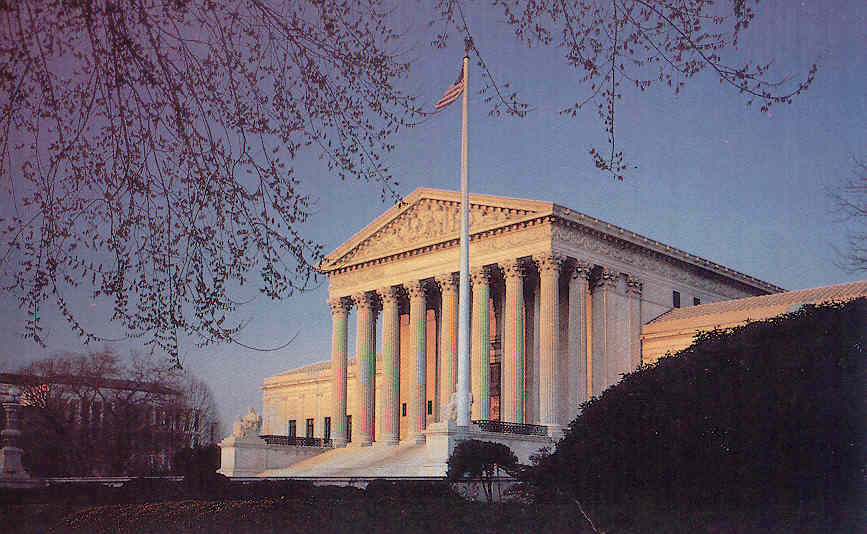
The Supreme Court gets in
on the cultural debate with a series of decisions
… in the name of
“constitutional
protections”
… which undercut deeply
traditional American social and cultural values
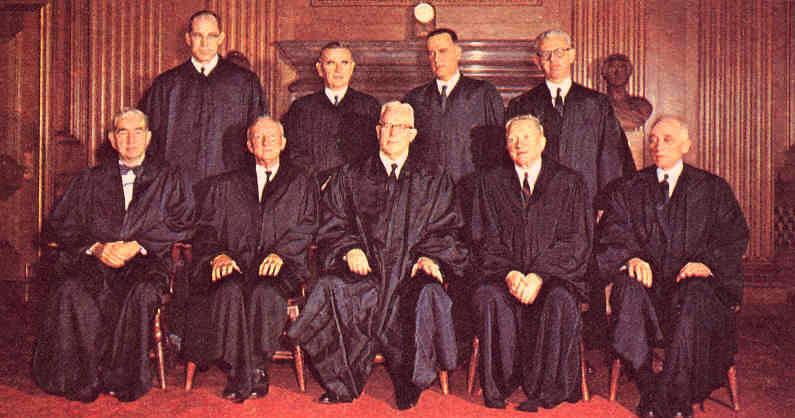
US Supreme Court Chief Justice Earl Warren (center) and the liberal court of the 1960s
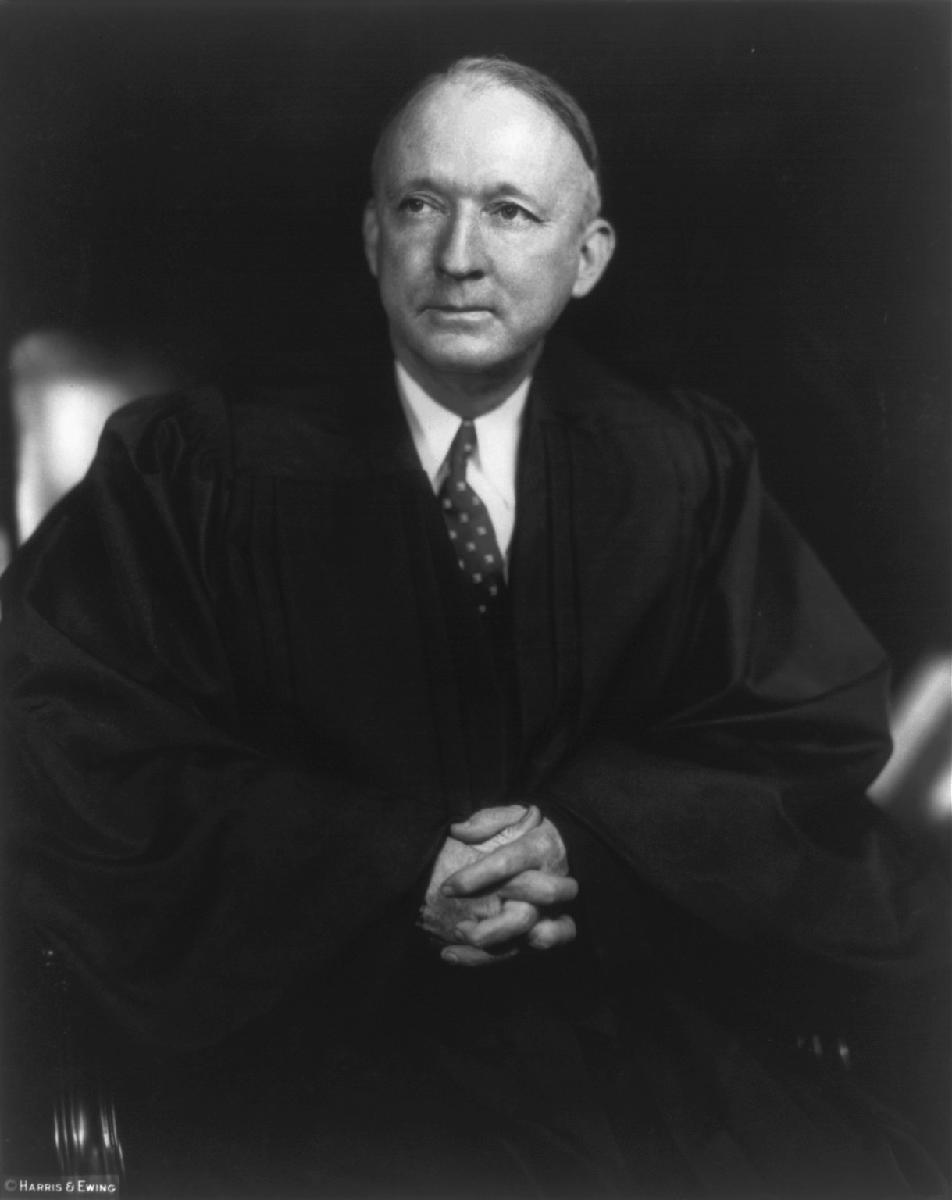
US Supreme Court Justice
Hugo Black who wrote a number of the Court's opinions
opposing any religious practice
in the nation's public schools
|
He wrote the
1947 Court opinion in the
Everson v. Board of Education case stating that the First Amendment
"erected a wall between church and state. . . . That wall must
be kept high and impregnable." He also wrote the 1962 Court opinion
in the Engel v. Vitale case stating that government-written prayers,
even broad non-denominational prayers, were not to be recited in public
schools as they violated the "Establishment Clause" of the first
Amendment. |
|
|
To the nation’s great horror, on November 22nd (1963) President Kennedy was shot and killed riding in an open convertible in a motorcade passing through the streets of Dallas, Texas, lined with cheering crowds. Wounded with him was Texas Governor John Connally who was riding in the seat immediately in front of Kennedy. The presumed assassin, Lee Harvey Oswald, was tracked to a movie theater and arrested ... but was himself assassinated by Jack Ruby two days later as Oswald was being transferred at the Dallas police headquarters to the county sheriff. The mindless horror of it all left the country in a state of deep shock. Oswald was known to have Cuban connections. Was this then a Communist plot? Ruby was known to have mob connections. Was this then a part of a mob hit to silence Oswald? Ultimately an investigation team under the direction of Supreme Court Chief Justice Earl Warren was assembled to look into the whole affair, and ten months later made its report with the verdict that both Oswald and Ruby had acted entirely alone, and that there was no trail of evidence that would lead further than simply those two individuals. There was much controversy stirred over the findings. But there really was no practical way to go deeper into the matter than the Warren Commission had gone. But conspiracy theories about the Kennedy assassination would abound, never to be resolved. In any case, with Kennedy’s death, America was about to enter unwittingly into radically new political territory, involving a political-social-cultural move that would soon tear the country apart.
|
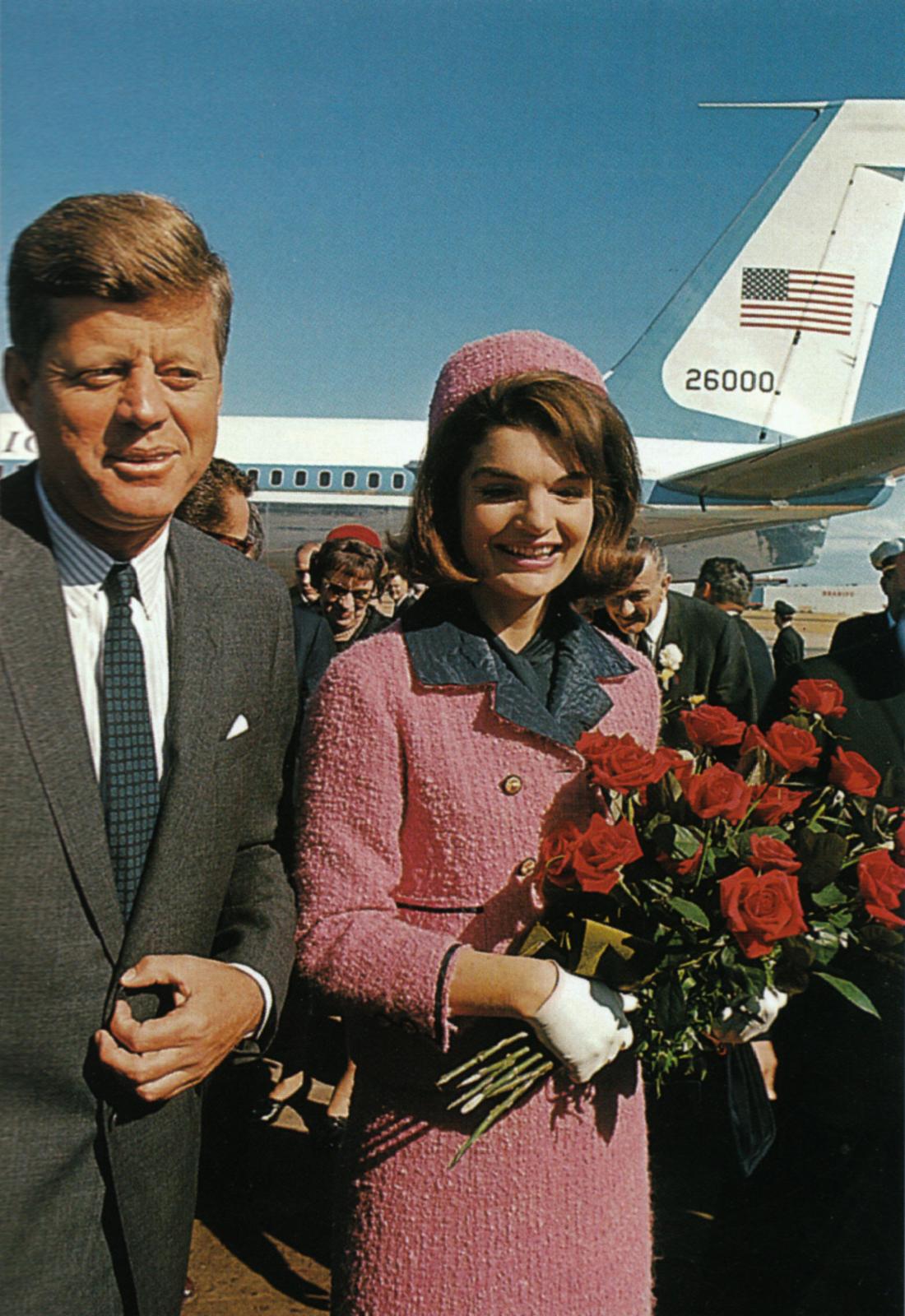
John and Jacqueline Kennedy
arrive in Dallas
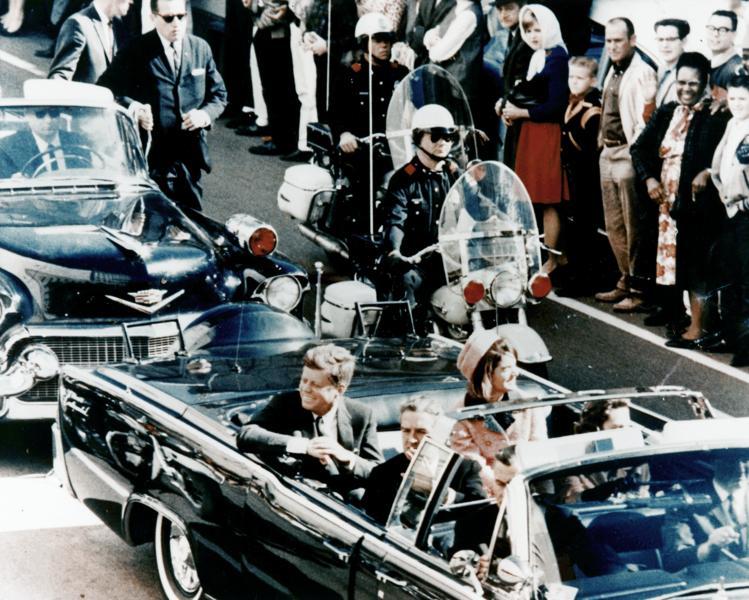
John and Jacqueline Kennedy
in Dallas limousine with Texas Governor John Connally
(who would also be wounded
in the shooting)
Frame from the Zapruder film
showing John Kennedy being shot
JFK shot – November 22, 1963
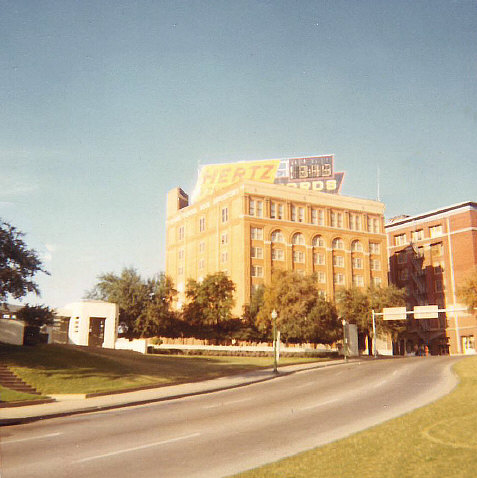
Dealey Plaza and the Texas
School Book Depository, Dallas, Texas, U.S.A., in November 1969,
site of the assassination
of John F. Kennedy on 22 November 1963,
its appearance little changed
in the intervening six years
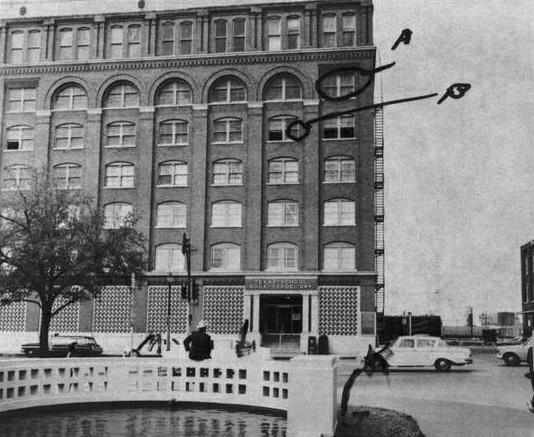
Howard Leslie Brennan sitting
across the street from the Texas School Book Depository
in the same position in
Dealey Plaza in Dallas where he saw a man shooting a rifle at
U.S. President John F. Kennedy
from the corner window of the sixth floor, on November 22, 1963
Circle "A" indicates where he saw
a man fire a rifle at the motorcade
and the
window (B) on the fifth
floor in which he saw people watching the motorcade.
Warren Commission Hearings
and Evidence
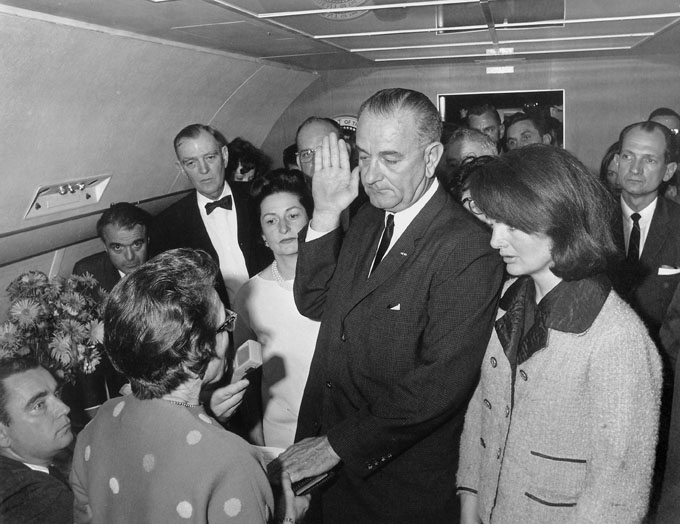
Lyndon Johnson takes the
Presidential oath of office aboard Air Force One
two hours after the
assassination of President John F.
Kennedy
Bobby and Jackie Kennedy
return to Washington after JFK's assassination – November
1963
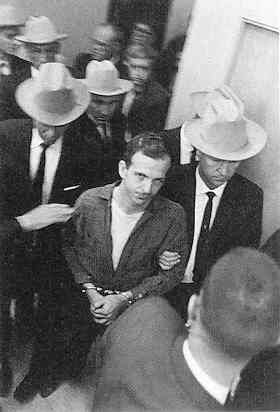
Lee Harvey Oswald, accused
assassin of President John Kennedy – 1963
Lee Harverty Oswald being
shot by Jack Ruby – 1963
Kennedy casket in the Capitol
Rotunda – 1963
Kennedy's funeral cortege
moving down Connecticut Ave. in Washington – November 25,
1963
John F. Kennedy's funeral
cortege in Washington, D.C. – November 25, 1963
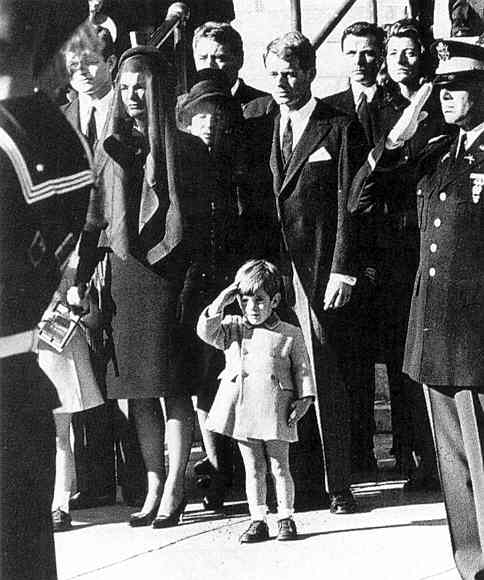
John-John salutes his father's coffin at the JFK funeral – November 1963
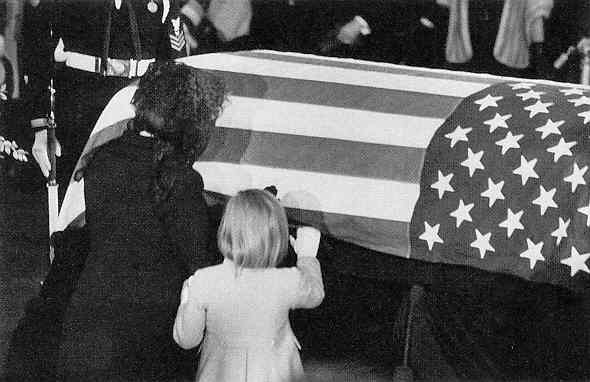
Jacqueline and Caroline Kennedy
at John Kennedy's coffin – 1963
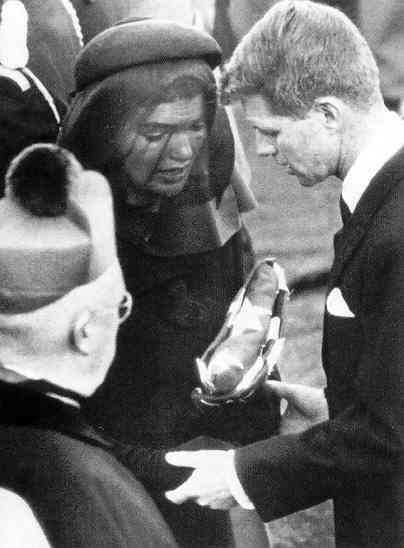
Jackie Kennedy receiving
the flag from her husband's coffin – 1963
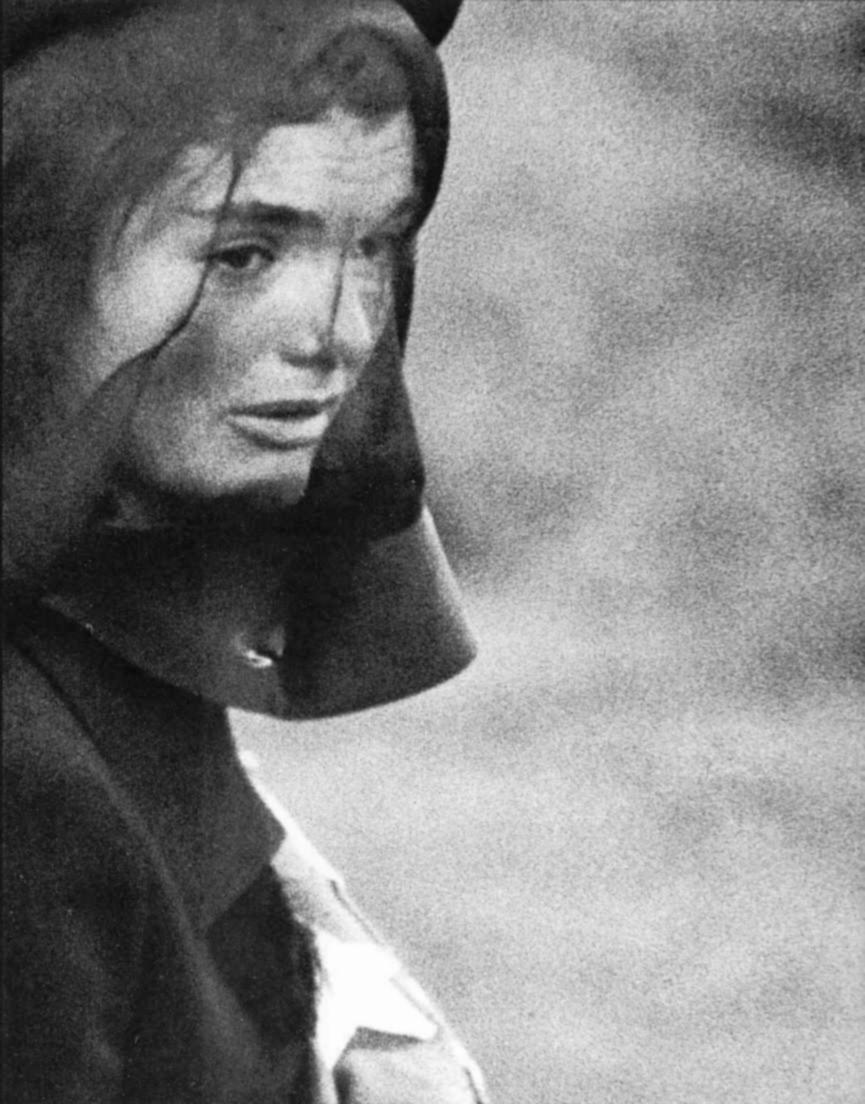
Jackie in
mourning
The Warren Commission presents
its report to President Johnson – 24 September 1964.
Despite many conspiracy
theories which proposed otherwise, the Commission
concluded
that both Oswald and Ruby
were acting alone, on their own personal
initiatives
 Miles
H. Hodges
Miles
H. Hodges